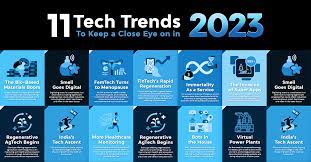
Unveiling the Latest Technology Trends: Shaping the Future of Innovation
Technology is constantly changing and evolving, and in the past few years we have seen some major trends emerge. From artificial intelligence to the Internet of Things, these trends are transforming the way we live, work, and play. Here are some of the biggest technology trends that are shaping our future.
- Artificial Intelligence: AI is becoming increasingly prevalent in our lives, from virtual assistants to self-driving cars. AI is being used to automate tasks, provide better customer service, and even improve healthcare outcomes. Companies like Google and Microsoft are investing heavily in AI research, and it’s likely that this technology will continue to be a major trend in the near future.
- Internet of Things (IoT): IoT is a network of connected devices that can communicate with each other and exchange data over the internet. This technology has been around for a while but it’s now becoming more widespread as more devices become “smart” – from light bulbs to refrigerators. IoT allows us to control our appliances remotely and automate mundane tasks like watering plants or turning off lights when we leave home.
- 5G: 5G is the fifth generation of cellular network technology which promises faster speeds than ever before – up to 10 times faster than 4G networks! This means faster downloads, better video streaming quality, and improved gaming experiences on mobile devices. 5G technology is already being rolled out in many countries around the world, so expect this trend to continue for some time yet!
- Cloud Computing: Cloud computing has been around for a while but it’s now becoming increasingly popular as more businesses move their data storage needs online instead of relying on physical servers or hard drives. This means companies can access their data from anywhere in the world without having to invest in expensive hardware or software solutions – making it easier than ever for businesses to stay connected no matter where they are located geographically!
- Augmented Reality (AR): AR is a technology that overlays digital images onto our real-world environment using cameras or sensors – think Pokémon Go! This tech has been used for entertainment purposes but it’s also being used in other industries such as healthcare and education to provide interactive experiences that weren’t possible before AR became available. We can expect this trend to continue growing as more companies explore how AR can be used in their products or services!
These five trends are just a few examples of how technology is changing our lives for the better – but there are many more out there! With new technologies emerging all the time, it’s important to stay up-to-date with what’s happening so you can make sure you don’t miss out on any opportunities these advancements might bring!
Exploring Key Technology Trends: FAQs on Emerging and Current IT Trends
- What are 5 emerging or current trends in information technology?
- What are the technology trends for 2024?
- What are current trends in technology?
- What are the current and emerging trends in technology?
What are 5 emerging or current trends in information technology?
Artificial Intelligence (AI): AI is becoming increasingly popular in many industries, from healthcare to finance and retail. AI is being used to automate processes, enhance customer experiences, and provide more accurate insights into businesses.
Cloud Computing: Cloud computing enables businesses to store and access data from any location, allowing them to scale up quickly and easily. It also enables them to reduce costs by eliminating the need for on-site hardware and software.
Internet of Things (IoT): IoT is a network of physical objects that are connected to the internet and can collect and exchange data with each other. This technology is being used in smart homes, wearables, connected cars, and more.
Big Data: Big data refers to large datasets that can be analyzed to gain insights into customer behavior, trends, or other information that can help businesses make better decisions.
5. Cybersecurity: Cybersecurity is becoming increasingly important as businesses rely more heavily on digital technologies for their operations. Companies are investing heavily in security solutions such as firewalls, encryption, and authentication measures to protect their networks from cyber attacks.
What are the technology trends for 2024?
Artificial Intelligence (AI) and Machine Learning (ML): AI and ML will continue to be the most important technology trends in 2024, as they are becoming increasingly integrated into many aspects of our lives. AI and ML will be used to automate processes, provide more accurate data analysis, and enable smarter decision-making.
Autonomous Vehicles: Autonomous vehicles are expected to become more commonplace in 2024, with self-driving cars being tested on public roads and autonomous drones being used for delivery services.
5G Networks: 5G networks are expected to become widely available in 2024, offering faster data speeds and more reliable connections than ever before. This will enable new technologies such as augmented reality (AR) and virtual reality (VR).
Internet of Things (IoT): IoT technology is expected to become increasingly integrated into everyday life in 2024, with smart home devices, wearables, connected cars, and other connected devices becoming commonplace.
Cloud Computing: Cloud computing will continue to be an important trend in 2024 as businesses move away from traditional IT infrastructure and towards cloud-based solutions for their IT needs.
6. Edge Computing: Edge computing is a relatively new concept that involves processing data closer to the source instead of relying on a centralized server or cloud platform. Edge computing is expected to become more widely adopted in 2024 as it can provide faster response times and improved security for IoT devices and other connected systems.
What are current trends in technology?
Artificial Intelligence (AI): AI is becoming increasingly popular as a technology that can be used to automate processes, analyze data, and provide insights.
Internet of Things (IoT): IoT is the concept of connecting everyday objects to the internet and allowing them to communicate with each other.
Cloud Computing: Cloud computing is a technology that allows for storage and access of data and applications over the internet.
Big Data: Big data is the collection and analysis of large amounts of data to gain insights into trends, patterns, and relationships.
Virtual Reality (VR): VR is a computer-generated simulation that can be used for entertainment or educational purposes.
6. Augmented Reality (AR): AR is a technology that overlays digital information onto physical objects or environments in real-time.
What are the current and emerging trends in technology?
Artificial Intelligence (AI): AI is becoming increasingly popular and is being used in a variety of applications, from facial recognition to autonomous vehicles.
Cloud Computing: Cloud computing is becoming more popular as businesses are looking to reduce costs and increase efficiency.
Internet of Things (IoT): IoT technology is connecting physical devices to the internet and allowing them to share data with each other. This technology is being used in smart homes, wearables, and connected cars.
5G: 5G networks are being rolled out around the world, offering faster speeds and lower latency than ever before.
Virtual Reality (VR) & Augmented Reality (AR): VR & AR are becoming increasingly popular as businesses look for ways to engage customers in new ways, such as virtual tours or immersive experiences.
6. Blockchain: Blockchain technology is revolutionizing the way data is stored and shared securely, making it an attractive option for businesses looking for more secure data storage solutions.

